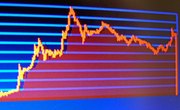
A percent of return is a term used to describe a return relative to the original amount. Percent of return is most commonly used in investing to compare investments of different sizes. Because the percent return measures the return based on the original amount, you can use the same formula to fairly compare investments of different sizes. In order to calculate the percent of return, you need to know the original investment and the ending amount. The ending amount can be the present value of the investment or the amount for which you sold the investment.
Divide the ending amount by the starting amount. For example, if you started with a $44,000 investment and ended with a $54,000 value, you would divide $54,000 by $44,000 to get 1.2273.
Subtract 1 from the previous step's result to find the return expressed as a decimal. In this example, you would take 1 away from 1.2273 to get 0.2273.
Multiply the rate of return from the previous step by 100 to convert to a percent of return. In this example, you would multiply 0.2273 by 100 to find you have a 22.73 percent return.
References
About the Author
Mark Kennan is a writer based in the Kansas City area, specializing in personal finance and business topics. He has been writing since 2009 and has been published by "Quicken," "TurboTax," and "The Motley Fool."
Photo Credits
graph bars image by Tomislav from Fotolia.com
